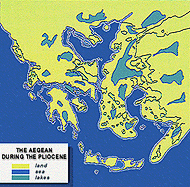 |
 ิhe land and sea formations in the area of Modern Greece and the Aegean
Sea were different to what we are familiar with today. The geomorphology
of the area was constantly changing, as a result of geological changes
that took place on our planet millions of years before the present (BP).
As well as geomorphological changes there were also climatic changes that
further determined the kind and behaviour of every form of life: fauna,
flora and Man. During the geological period of the Miocene, about 30 millions
years BP, Aegaeis rose from the depths of what we call today the Mediterranean
sea. It was a single land mass which contained the modern Balkan peninsula,
the Aegean and Asia Minor and extended from the Adriatic sea to Crete.
ิhe land and sea formations in the area of Modern Greece and the Aegean
Sea were different to what we are familiar with today. The geomorphology
of the area was constantly changing, as a result of geological changes
that took place on our planet millions of years before the present (BP).
As well as geomorphological changes there were also climatic changes that
further determined the kind and behaviour of every form of life: fauna,
flora and Man. During the geological period of the Miocene, about 30 millions
years BP, Aegaeis rose from the depths of what we call today the Mediterranean
sea. It was a single land mass which contained the modern Balkan peninsula,
the Aegean and Asia Minor and extended from the Adriatic sea to Crete.
|

Towards the end of the Miocene, approximately 5 millions years BP, submersions and elevations took place with the result that huge masses of water penetrated this vast land, forming a part of the Aegean and large interior lakes. |
|
|

|
